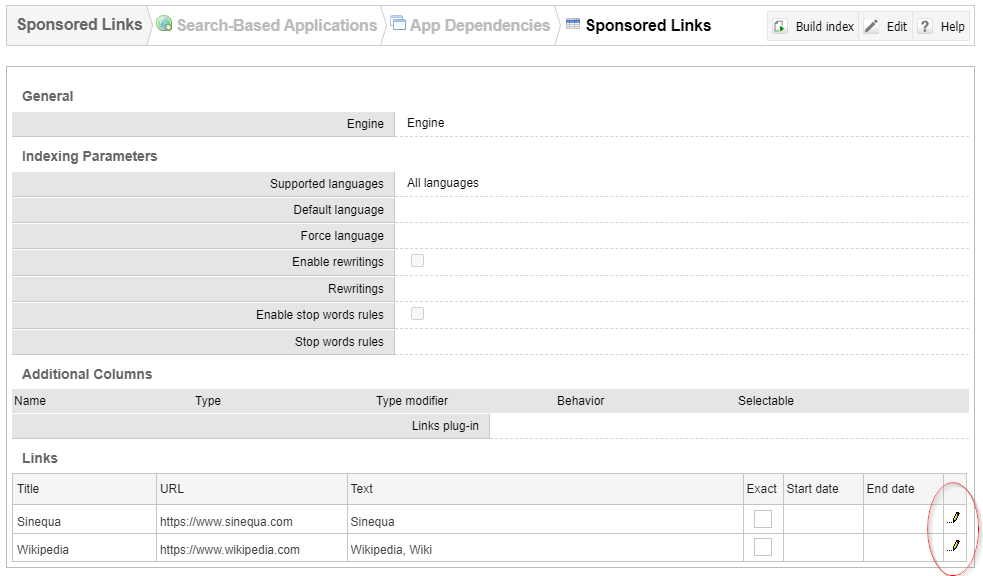Result Module
Features
This module provides simple components to easily display the different fields of a document/result/record (object of type Record).
These components do not depend on a styling framework like Bootstrap, nor on a global stylesheet.

Import
Import this module in your app.module.ts.
import { ResultModule } from '@sinequa/components/result';
@NgModule({
imports: [
...
ResultModule
This module is internationalized: If not already the case, you need to import its messages for the language(s) of your application. For example, in your app's src/locales/en.ts:
...
import {enResult} from "@sinequa/components/result";
const messages = Utils.merge({}, ..., enResult, appMessages);
Components
Title
The sq-result-title component displays the title of a document. More precisely, it displays the record.displayTitle (formatted value) or record.title (raw value), or a custom field (field input).
When the title is clicked, various behaviour are possible (titleLinkBehavior field):
'open'(default): The title is a regular link pointing atrecord.url1if it exists (thetitleClickedevent fires for information and an audit event is emitted).'action': the title is a link pointing at no URL, the action is custom and must be performed by the parent via thetitleClickedevent.
Source
The sq-result-source component displays the treepath (record.treepath) and URL (record.url1) of a document.
Extracts
The sq-result-extracts component displays the relevant extracts of a document in a summarized form (record.relevantExtracts) or raw form (record.extracts). It can also display the record.text if that field is configured in the Query web service. It also displays the modified date of a document (record.modified).
Thumbnail
The sq-result-thumbnail component displays the thumbnail of a document, if it exists. The behavior of a thumbnail click is similar to the title component.
Icon
The sq-result-icon component displays the icon of a document, defined by its file extension (record.fileExt). This component simply inserts a <span> element with a class name including the file extension.
The extensions are mapped with icons and colors in the TypeScript. A default mapping of file extension (string) to an icon and color (IconFormat) is defined in the component.
Custom icons can be provided via the formatIcons input from the component which you can use to both override the ones defined by default, and to add some extensions that may not be in that list. For example:
const formatIcons: Record<string, IconFormat> = {
"html": { icon: "fas fa-browser", color: 'purple' },
"abcd": { icon: "fas fa-users", color: '#123456' }
}
Vanilla Search allows overriding the mappings using the app configuration on the server (as for the facets, metadata, etc.) or it could be also defined in config.ts.
Missing terms
The sq-missing-terms component displays the list of terms in the user's query that are not found in the document.
Sponsored Results
The sq-sponsored-results component displays the sponsored links relevant for a user query (using the SponsoredLinksWebService). The configuration of these links must be done in the Sinequa administration.
<sq-sponsored-results [query]="searchService.query"></sq-sponsored-results>
Note that, in the background, the SponsoredLinksWebService makes a call to the query.links API endpoint, every time the query text is modified (which does not include clicks on facets for example).
The configuration of the links is done as depicted below in the Sinequa administration. Notice the bottom-right buttons to edit the properties of each link (including their thumbnail). See the general documentation about Sponsored Links.

User ratings
The sq-user-rating component displays the rating of a given document in the form of a number of stars. Users can assign a rating to a document by clicking on a star: This stores each user's rating (as a number) in the engine metadata store, and additionally it computes the average rating from all users (which is stored in a different column).
Note that the column names are case sensitive (should always be lower case), and aliases are not supported.
In the background, the component uses the UserRatingsWebService to update the engine metadata store. This web service has no configuration on the backend (at the moment). This is why it is required to pass the index column names to the component directly.
As a pre-requisite, an Engine Metadata store must exist on the backend, and the engine* columns must have been created. Note that the ratingsColumn should normally be an engineusercsv column, since it needs to store the rating for each user. Whereas the averageColumn should be an enginecsv column to store the average for all users (See Implementing the Engine Metadata).
⚠️ Note that inserting user ratings in your SBA has no direct effect on the relevance computed by the engine. To influence the relevance (= the ranking of results), you must configure your Query web service to boost or penalize rated documents:

The sq-user-rating component supports additional optional parameters:
values: By default, the rating values stored in the index are digits from1tocount, but it is possible to instead store strings provided in thisvaluesinput. For example:terrible;poor;average;good;perfect.titles: Similar tovalues, this input allows to define the tooltip texts displayed when hovering over the stars.caption: A caption for the ratings, displayed before the stars.showAverage: A boolean to display or not the average rating from all users (after the stars).
Duplicate documents
This module includes 3 components to manage duplicate documents:
-
Exact duplicates are the documents excluded from the results list by the engine, using a "group by" clause. This deduplication is generally based on the
exacthashornearhashcolumns. By definition, exact duplicates are not returned by the WebApp and therefore NOT displayed in the result list. -
Near (or approximate) duplicates are determined by a developer-supplied function (in the
SearchOptions) that compares two documents and returns a boolean. By definition, near duplicates are returned by the WebApp and present in the result list (only their appearance is modified). The order of the results list is not modified and a near duplicate always follows either its "parent" document or another near duplicate.
sq-result-duplicates displays the number of exact and near duplicates of a document.
sq-result-duplicates-spacer: A component that visually differentiates near duplicates in a results list.
sq-result-duplicates-list: Retrieves and displays the list of exact duplicates for a given document.
<sq-result-duplicates-list [record]="record"></sq-result-duplicates-list>